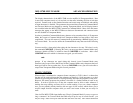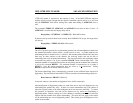
MFJ-1278B MULTI-MODE ADVANCED OPERATION
You can have your station periodically send an automatic message by enabling "beacons." A
beacon can be used to make general-interest announcements, provide packets for other
stations to use to test their ability to receive, or announce the presence of a bulletin-board
operation. The beacon message is set with the command BTEXT, which works the same
way as the CTEXT command. You enable beacon transmission and set the frequency at
which beacons are sent with the command BEACON. To transmit the beacon at 10-second
intervals, for example, give the command
cmd: BEACON EVERY 1
The beacon function also has a transmit-after mode, enabled by using the keyword AFTER
in place of EVERY, in which a beacon packet is only transmitted after activity is heard on
the channel. This feature might be used to leave an announcement for other packet users. If
someone transmits on an otherwise idle channel, a beacon can be sent a short time later. No
beacons are sent in this mode if there is a lot of packet activity on the channel, since the
required period of quiet will not occur.
Unattended Operations
Individuals who want to leave their MFJ-1278B on overnight can monitor packets even with
the terminal or computer off. Just type CTRL-S then turn the terminal or computer off. The
next morning turn the computer on, then type CTRL-Q. The MFJ-1278B will dump
everything monitored during the night limited only by the amount of available RAM.
The MFJ-1278B can operate unattended for extended periods of time. If you would like to
have the MFJ-1278B operate as a digipeater but not connect with a station, be sure to set
DIGIPEAT ON and CONOK OFF. This is probably most useful when setting up a
dedicated digipeater in a remote location.
Packet Formatting
The maximum length of a packet is determined by the command PACLEN. If you type more
than the maximum number of characters without entering a send-packet character, the MFJ-
1278B will transmit a maximum-length packet. In Transparent Mode, a packet will be sent if
the maximum number of characters is entered before the delay conditions set by PACTIME
force a packet to be sent. Some MFJ-1278Bs may not be able to accept packets longer than
128 characters.
If you have set the send-packet character to <CR>, you probably want the <CR> to be
included in the packet for display at the other end. If you set the send-packet character to a
special non-printing character, you probably want the character to be treated as a command
only. The command CR controls whether the send-packet character is to be echoed and
included in the packet.


















